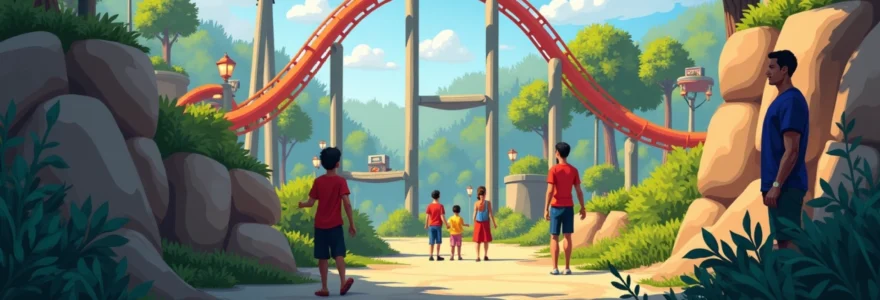Adventure parks have become increasingly popular destinations for families seeking excitement and bonding experiences. These carefully designed spaces offer a unique blend of thrilling activities and safe environments, catering to both adrenaline junkies and those who prefer gentler adventures. As the industry evolves, park designers and engineers face the challenge of creating attractions that appeal to all ages while maintaining the highest safety standards.
Designing adventure parks: balancing safety and excitement
The art of designing adventure parks lies in striking the perfect balance between heart-pounding excitement and unwavering safety. Engineers and designers must consider a myriad of factors to ensure that each attraction provides an exhilarating experience without compromising on security. This delicate equilibrium is achieved through meticulous planning, innovative engineering, and rigorous testing.
One of the primary considerations in adventure park design is the diversity of visitors. Families often include members of various ages, physical abilities, and thrill-seeking appetites. As such, parks must offer a range of activities that cater to everyone from toddlers to grandparents. This inclusive approach not only enhances the family experience but also broadens the park’s appeal to a wider audience.
The layout of an adventure park plays a crucial role in its success. Designers carefully plan the placement of attractions to create a natural flow throughout the park, ensuring that visitors can easily navigate between different zones. This thoughtful arrangement also helps in managing crowd distribution and minimizing wait times, which are essential factors in maintaining a positive visitor experience.
Thrill ride engineering: from zip lines to roller coasters
The engineering behind thrill rides is a fascinating blend of physics, material science, and creative design. From the swooping arcs of zip lines to the stomach-churning drops of roller coasters, each attraction is a testament to human ingenuity and our never-ending quest for excitement.
G-force calculations in adventure park attractions
Understanding and controlling G-forces is paramount in designing safe yet thrilling rides. Engineers use sophisticated computer models to calculate the forces exerted on riders during various parts of an attraction. These calculations help determine the optimal track layout, speed, and acceleration to provide an exhilarating experience without causing discomfort or potential harm to riders.
For example, a well-designed roller coaster might subject riders to positive G-forces of up to 3-4 Gs during tight turns or loops, creating a sensation of weightlessness without exceeding safe limits. Negative G-forces, which can cause a floating sensation, are typically limited to around -1 G to prevent disorientation or nausea.
Material science in High-Tension cable systems
The safety and durability of high-tension cable systems, such as those used in zip lines and aerial adventure courses, rely heavily on advancements in material science. Modern cables are typically made from high-strength steel alloys or synthetic materials like Kevlar, which offer exceptional tensile strength and resistance to wear.
Engineers must consider factors such as temperature fluctuations, UV exposure, and repeated stress when selecting materials for these systems. Regular non-destructive testing, such as magnetic particle inspection or ultrasonic testing, is employed to detect any microscopic flaws that could compromise the integrity of the cables.
Computerized control systems for dynamic rides
Modern thrill rides often incorporate sophisticated computerized control systems to enhance both safety and excitement. These systems monitor various parameters in real-time, including speed, acceleration, and passenger restraints. In the event of any anomaly, the system can automatically initiate safety protocols, such as slowing or stopping the ride.
Advanced control systems also allow for dynamic ride experiences. For instance, some roller coasters can adjust their speed and intensity based on factors like weather conditions or the weight distribution of passengers, ensuring a consistent thrill level for all riders.
Ergonomic design principles for All-Ages accessibility
Creating attractions that are accessible and enjoyable for visitors of all ages requires a deep understanding of ergonomics. Designers must consider factors such as seat dimensions, restraint systems, and entry/exit points to accommodate a wide range of body types and physical abilities.
For example, a family-friendly roller coaster might feature adjustable restraints that can securely hold both small children and larger adults. Similarly, the design of queue lines and loading platforms must account for visitors with mobility challenges, ensuring that everyone can safely and comfortably access the attraction.
Adventure park ecosystems: integrating nature and technology
Modern adventure parks are increasingly focusing on integrating their attractions with the natural environment. This approach not only enhances the visitor experience but also promotes environmental awareness and conservation efforts. The challenge lies in creating thrilling experiences that coexist harmoniously with the surrounding ecosystem.
Arboreal platforms: structural integrity in living trees
Tree-based attractions, such as canopy walks and aerial adventure courses, require careful engineering to ensure the health of the trees and the safety of visitors. Arborists and structural engineers collaborate to design platforms and attachment systems that distribute weight evenly and allow for tree growth.
Innovative techniques, such as dynamic rigging systems, allow for slight movement of platforms in response to wind or tree growth, reducing stress on the tree. Regular inspections and adjustments are crucial to maintain the integrity of these living structures.
Eco-friendly power systems for remote park locations
Many adventure parks are located in remote areas, presenting unique challenges for power supply. To minimize environmental impact and reduce operational costs, parks are increasingly turning to renewable energy sources. Solar panels, wind turbines, and micro-hydro systems can be integrated into the park’s design, providing clean energy for attractions, lighting, and facilities.
These eco-friendly power systems not only reduce the park’s carbon footprint but can also serve as educational tools, demonstrating sustainable technologies to visitors.
Wildlife coexistence strategies in adventure landscapes
Designing adventure parks that coexist with local wildlife requires careful planning and ongoing management. Strategies may include creating wildlife corridors, implementing noise reduction measures, and scheduling activities to minimize disturbance during critical periods such as breeding seasons.
Some parks have successfully integrated wildlife viewing opportunities into their attractions, allowing visitors to observe animals in their natural habitats while maintaining a safe distance. This approach can foster a deeper appreciation for nature and promote conservation efforts.
Psychological aspects of Family-Oriented thrill experiences
The psychology behind thrill-seeking behaviour is a fascinating aspect of adventure park design. Understanding what drives people to seek out exciting experiences, and how these experiences affect family dynamics, is crucial for creating attractions that appeal to a wide range of visitors.
Research has shown that controlled exposure to thrilling experiences can have positive psychological effects, including increased self-confidence and improved stress management skills. For families, shared adventures can strengthen bonds and create lasting memories.
Adventure park designers must consider the emotional journey of visitors, creating a narrative arc throughout the park that builds excitement while providing moments of respite. This careful pacing helps maintain engagement and prevents overstimulation, especially for younger visitors or those less accustomed to intense experiences.
The concept of “perceived risk” plays a significant role in the design of family-oriented thrill rides. While safety is paramount, the illusion of danger can be just as thrilling as actual risk. Designers use various techniques to create this perception, such as near-miss elements or visual effects that enhance the sense of speed or height.
Risk management and safety protocols in adventure parks
Ensuring the safety of visitors is the top priority for any adventure park. Comprehensive risk management strategies and stringent safety protocols are essential for maintaining a safe environment while delivering exciting experiences.
Non-destructive testing methods for adventure equipment
Regular inspection and testing of equipment are crucial for preventing accidents and ensuring long-term reliability. Non-destructive testing (NDT) methods allow park operators to examine critical components without causing damage. Common NDT techniques used in adventure parks include:
- Ultrasonic testing for detecting internal flaws in metal structures
- Magnetic particle inspection for surface and near-surface defects
- Radiographic testing for examining welds and joints
- Eddy current testing for detecting cracks in conductive materials
These advanced testing methods help identify potential issues before they become safety hazards, allowing for proactive maintenance and replacement of worn components.
Emergency response systems and evacuation procedures
Despite rigorous safety measures, adventure parks must be prepared for emergencies. Comprehensive emergency response systems and well-rehearsed evacuation procedures are essential for minimizing risks and ensuring rapid assistance when needed.
Modern parks often employ integrated communication systems that allow staff to quickly coordinate responses to incidents. These systems may include features such as:
- GPS tracking of visitors and staff
- Automated alerts for weather conditions or equipment malfunctions
- Real-time monitoring of ride operations and queue management
- Centralized control centers for overseeing park-wide safety
Regular training and drills ensure that staff are prepared to handle various emergency scenarios, from medical incidents to large-scale evacuations.
Biomechanical analysis of impact forces in fall arrest systems
For attractions involving heights, such as climbing walls or aerial courses, fall arrest systems are critical safety components. The design of these systems requires a deep understanding of biomechanics to ensure that they effectively protect users from injury in the event of a fall.
Engineers use sophisticated computer models to simulate falls and analyze the forces exerted on the human body during sudden deceleration. This analysis helps in designing harnesses, lanyards, and anchor points that distribute impact forces safely, minimizing the risk of injury.
Weather monitoring technologies for outdoor adventure facilities
Weather conditions can significantly impact the safety and enjoyment of outdoor attractions. Advanced weather monitoring systems allow park operators to make informed decisions about ride operations and visitor safety.
These systems may include:
- On-site weather stations for real-time data collection
- Lightning detection systems for early warning of electrical storms
- Wind speed and direction sensors for monitoring conditions at height
- Integration with regional weather forecasting services for improved prediction accuracy
By closely monitoring weather conditions, park operators can take proactive measures to ensure visitor safety, such as temporarily closing exposed attractions during high winds or evacuating areas in advance of severe weather.
Case studies: innovative family adventure parks worldwide
Examining successful family adventure parks around the world provides valuable insights into effective design strategies and innovative approaches to balancing thrill and safety. These case studies showcase how parks have adapted to local environments, cultural preferences, and technological advancements to create unique and memorable experiences for visitors of all ages.
One notable example is the Fuji-Q Highland in Japan, known for its record-breaking roller coasters and stunning views of Mount Fuji. The park has successfully integrated cutting-edge technology with traditional Japanese aesthetics, creating a unique blend of thrills and cultural experiences. Their “Takabisha” roller coaster, with its 121-degree drop, demonstrates how parks can push the boundaries of engineering while maintaining strict safety standards.
In contrast, the TreeTop Adventure Park in Australia takes a more nature-centric approach, offering a series of suspended bridges, flying foxes, and cargo nets set high in the eucalyptus canopy. This park exemplifies how adventure attractions can be seamlessly integrated into natural environments, providing thrilling experiences while promoting environmental awareness and conservation.
The Zip World in Wales has gained international recognition for its innovative use of former industrial sites. By repurposing abandoned slate quarries, the park has created unique attractions such as the world’s fastest zip line and underground trampolining caverns. This approach not only provides exciting adventures but also contributes to the economic regeneration of post-industrial areas.
These diverse examples illustrate the global trend towards creating immersive, multi-faceted adventure experiences that cater to a wide range of preferences and abilities within family groups. By combining thrilling attractions with educational elements, cultural experiences, and stunning natural or historical settings, these parks are redefining what it means to be a family adventure destination.


